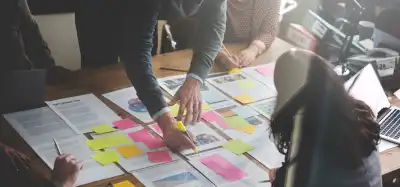In our society, businesses have tremendous power over how we all live and work. That is why they must be included in the conversation regarding racial inequality in our country. The prospect of an NBA strike over the police shooting of Jacob Blake in 2020 demonstrated that when big business is involved, the world listens. On the other hand, staying silent is a statement of its own.
Amid recent protests against police brutality and systemic racism, many other brands have made announcements in solidarity of the Black Lives Matter movement and have called for government action. Some CEOs have also committed to increase diversity efforts in their companies and to fund social justice groups.
While these moves should be celebrated, they are not enough to establish an equitable society, especially for Black and Indigenous people. Truly great leaders must not only speak up against injustices, but also be ready to lead increasingly diverse workforces and organizations. For many, the ongoing work toward equality and inclusion is just beginning.
One Yale School of Management leadership expert, Heidi Brooks, sees that many businesses are failing to adequately address the needs of a diverse workforce.
Brooks warns businesses to be wary of the simple solution. This can run against biases toward immediate action that are not always suitable for addressing complex problems.
Brooks says business culture often mistakenly equates constant action and motion with valuable impact. The truth is that our institutions and current ways of thinking are not equipped to solve problems as complex as racial inequality. Instead, what happens is that people jump to the parts of the problem they think they can solve to feel like they accomplished something.
Brooks encourages everyone to “usefully complicate” the issues we’re trying to work on. For example, simply hiring more BIPOC talent into a culture that has not thought comprehensively about diversity will not address regressive policies and an environment that puts BIPOC at a disadvantage. Brooks gave the example of corporate policies that prohibit Black employees from wearing natural hairstyles to work.
Goals for increasing BIPOC talent need to be paired with goals for creating a constructive environment for those whose experiences differ from the majority’s.
“We need to work smarter, ask the right questions, and really understand both the magnitude, complexity, breadth, and depth of what we’re taking on before we pour valuable resources of time and dollars that we can not repeat,” says Brooks.

Using power wisely
One way to examine inequality is through the lens of power. At Yale, Brooks teaches courses on “Interpersonal & Group Dynamics” and “Everyday Leadership,” which she defines as, “the everyday micro-moments of impact that shape our lived experience.” Brooks says everything that is happening at a societal level is also happening at the individual level. So, she suggests leaders analyze how they use positional power at different levels — intrapersonally, interpersonally, in groups, and organizationally. Set a goal to build a nuanced view on power and how it impacts yourself and others across various scenarios. Who has influence? Is that influence being used to create a supportive and uplifting environment?
Some other questions to reflect on include:
- As a leader, do you give yourself the chance to be heard and seen?
- As a leader, do you confront or address issues when you hear something happening in a meeting that goes against your values and your principles?
- How does the way you give feedback either elevate or crush people?
- Do you create a feeling of mutuality, an environment where both parties have the ability to develop and uplift the capacity of another?
- Do you do these things across demographics, or only with people who are most similar to you?
Everyone has room for improvement. Once you see where you can improve, then you can start measuring whether your efforts are having an impact on your company’s culture. There are several metrics that can be useful to monitor: Are people showing up to diversity and inclusion meetings? Whose projects are getting funded? Who do you staff your teams with? Are mentors and mentees both getting a mutual benefit from their relationship?
“The everyday shape of how we work together, we can study the process of that. And then begin to see how that relates to the outcomes we say that we want,” says Brooks. “If we say we want those outcomes, we have to produce the daily behaviors that actually predict the outcomes.”
This will all take time. And not everyone will be on board at first. Brooks says cultural change happens in phases, starting with innovators and early adopters and building up to a majority. One mistake to avoid is trying to win over the resistors immediately.
“Do a bit of stakeholder mapping about who might be the innovators who are with you early on, who are the people who actually can build an alliance and a coalition for the possibility of a new way,” says Brooks. “And you work with those people first and you build some collective and mutual power, engaged in a positive vision and aspiration of the future.”

Leading with vulnerability
What companies should be aiming for is making sure everyone is able to thrive in the organization. Accomplishing true equity often requires challenging the status quo, which can be uncomfortable for both the beneficiaries and those hurt by the current state of affairs.
“I call it democratization of discomfort,” says Yale psychologist Jennifer Richeson about increasing anxieties among white people due to the changing demographics in America. “There were whole swaths of people uncomfortable all of the time. Now we’re democratizing it. Now more people across different races and religions feel uncomfortable.”
Establishing psychological safety is important to work through this discomfort. Psychological safety is a term coined by Harvard Business School Professor Amy Edmondson and is the idea of not fearing interpersonal reprisal for risk-taking when you use your voice or try something new.
This sense of safety is at the cornerstone of a new work culture where people feel comfortable holding each other accountable in an encouraging way and not through shaming and blaming.
According to Brooks, leaders can start establishing psychological safety by being vulnerable. Leaders should share their fears, thoughts, internal conflicts, and questions about race. This will help others do the same.
You may not want to center yourself in the conversation and you shouldn’t, but you can use your power to promote change.
“If fear wins, the status quo will win,” says Brooks.
If you’re interested in starting our OKRs 101 course, click here.



